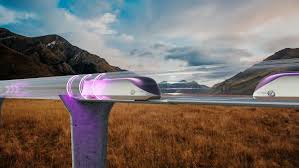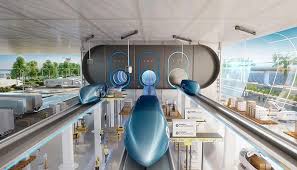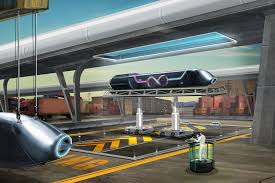
What is Hyperloop Transportation?
Hyperloop is a proposed high-speed transportation system that uses vacuum tubes and magnetic levitation to transport people and goods at incredible speeds—potentially faster than air travel. This futuristic mode of transport was first conceptualized by Elon Musk in 2013, aiming to provide a more efficient, eco-friendly alternative to current transport systems.
The basic principle behind Hyperloop is to create a near-vacuum environment in low-pressure tubes, which reduces air resistance. Within these tubes, passenger pods are propelled at high speeds using magnetic forces, allowing them to travel faster and more efficiently than traditional modes of transport like trains, cars, and planes.
How Hyperloop Works
- Vacuum Tubes: The Hyperloop system operates within a sealed, low-pressure tube. This tube is designed to reduce air resistance (drag), making it easier for the pods to travel at high speeds without expending excessive energy.
- Magnetic Levitation: Inside the tube, the passenger pods are suspended and propelled by magnetic levitation (maglev) systems. Maglev uses magnetic forces to lift and push the pods forward, eliminating friction and allowing for smooth, high-speed travel.
- Solar Power: The system is designed to be energy-efficient. Solar panels along the length of the tubes would provide power to keep the system running, making it a sustainable mode of transport.
- Pods: The passenger pods, or “capsules,” are streamlined to minimize air resistance. These pods will travel in and out of the vacuum tube, providing a safe and fast way for passengers to reach their destination.

Key Features of Hyperloop
- High Speed: Hyperloop could reach speeds of up to 760 mph (1,220 km/h), significantly faster than high-speed trains and even airplanes. This would drastically reduce travel times between cities, such as cutting a 6-hour drive down to just 30 minutes.
- Energy Efficiency: Because the system operates in a near-vacuum environment, it uses less energy than traditional transportation systems. The incorporation of renewable energy sources (e.g., solar power) further enhances its sustainability.
- Comfort and Safety: Hyperloop pods are designed to be safe and comfortable, with shock absorption systems to protect passengers from sudden accelerations. The lack of friction also leads to a smoother ride compared to conventional transport.
- Environmental Impact: The environmental benefits of Hyperloop are significant. The low energy consumption and the potential to be powered entirely by renewable energy sources could make it a greener alternative to other modes of transportation.
Benefits of Hyperloop Transportation

- Speed and Efficiency: The most obvious benefit is the dramatic reduction in travel time. Hyperloop could make intercity travel faster, more convenient, and less stressful.
- Cost-Effectiveness: While the initial investment in infrastructure is high, operational costs could be lower than traditional transport systems due to the efficiency of the design. Additionally, the reduced travel time could boost productivity and economic growth.
- Eco-Friendly: By running on renewable energy and using fewer resources, Hyperloop could significantly reduce the carbon footprint associated with travel, especially compared to air travel and automobiles.
- Reduced Traffic Congestion: If implemented widely, Hyperloop could reduce the strain on existing road and rail networks, offering an alternative to overcrowded highways and airports.
- Disaster Relief and Emergency Travel: The speed and flexibility of Hyperloop could make it a valuable asset in disaster response, allowing for rapid transportation of aid and personnel to affected areas.
Challenges and Limitations
- High Infrastructure Costs: Building the necessary infrastructure for Hyperloop (including the tubes, stations, and energy sources) would require a significant upfront investment. Construction in densely populated or geologically challenging areas could be particularly difficult and expensive.
- Technological and Engineering Challenges: While prototypes have been tested, scaling the technology to operate safely and efficiently at full speed across long distances remains a significant challenge. Overcoming the challenges of maintaining a near-vacuum over large distances, managing the magnetic levitation system, and ensuring the safety of passengers will take time.
- Regulatory and Safety Concerns: Governments and regulatory bodies would need to address the safety standards for Hyperloop, including emergency protocols, air pressure systems, and crashworthiness. Public acceptance could also take time, as people are often hesitant to adopt new transportation technologies.
- Competition with Other Modes of Transport: While Hyperloop is promising, it faces stiff competition from other forms of transportation such as high-speed trains, electric vehicles, and even autonomous cars. For Hyperloop to succeed, it will need to offer clear advantages over existing options.
Current Status and Companies Involved
Several companies and organizations are currently working on the development of Hyperloop, including:
- Virgin Hyperloop: One of the most prominent companies working on Hyperloop technology, Virgin Hyperloop has conducted successful tests of the system and is pushing forward with plans for commercial implementation.
- Elon Musk’s Boring Company: Though the Boring Company is focused on building tunnels for urban transportation, its projects align with the Hyperloop vision. It aims to use similar principles to create high-speed transport systems for city commutes.
- Hyperloop Transportation Technologies (HTT): Another key player in the race to bring Hyperloop to life, HTT is focused on building the infrastructure and establishing partnerships with governments and cities around the world.
Future of Hyperloop
The future of Hyperloop is promising, but it will take time to realize its full potential. The technology is still in the testing phase, with several successful prototypes demonstrating its feasibility. The next step involves scaling up the technology to handle commercial demand, constructing the necessary infrastructure, and navigating regulatory challenges.
If successful, Hyperloop could revolutionize the way people travel, making long-distance trips quicker, more efficient, and more sustainable. As development continues and more investments pour into the sector, we could see the first operational Hyperloop systems within the next decade, especially in regions with heavy demand for high-speed transport.
Conclusion
Hyperloop is a groundbreaking innovation that promises to transform the transportation landscape. With its potential to reduce travel times, improve energy efficiency, and reduce environmental impact, it offers a glimpse into the future of transportation. However, significant challenges remain, particularly in terms of infrastructure costs and technological hurdles. As testing continues and development progresses, Hyperloop may soon change how we think about long-distance travel.

